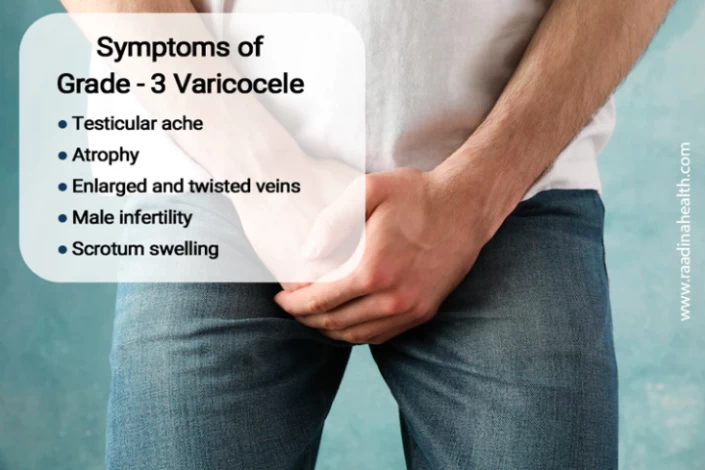Nonsurgical Treatment for Male Infertility Caused by Varicoceles
A varicocele is a varicose vein of the testicle and scrotum that may cause pain and lead to testicular atrophy (shrinkage of the testicles).
In healthy veins within the scrotum, one-way valves allow blood to flow from the testicles and scrotum back to the heart. In a varicocele, these valves do not function properly, causing blood to pool enlarging the vein. Some experts believe that the raised temperature that results from the pooled blood in these blocked veins can decrease sperm count and motility of sperm and increase the number of deformed sperm. In fact, the incidence of varicoceles increases to 30 percent in couples who cannot have children.
When these valves fail, the blood pools and enlarges the veins around the testicle in the scrotum to cause a varicocele. Open surgical ligation, performed by a urologist, is the most common treatment for symptomatic varicoceles. Varicocele embolization, a nonsurgical treatment performed by an interventional radiologist, is as effective as surgery with less risk, less pain and less recovery time. Patients considering surgical treatment should also get a second opinion from an interventional radiologist to ensure they know all of their treatment options. You can ask for a referral from your doctor, call the radiology department of any hospital and ask for interventional radiology or visit the doctor finder link at the top of this page to locate a doctor near you.
Prevalence
- Approximately 10 percent of all men have varicoceles.
- Among infertile couples, 30 percent of men have varicoceles.
- The highest occurrence of varicoceles is in men ages 15–35.
- 80,000–100,000 men in America may undergo surgical correction of varicoceles each year.
Symptoms
Pain: Men who experience pain in their testicles—particularly when exercising, standing or sitting for a long period of time—may be suffering from varicoceles. Typically, painful varicoceles are prominent in size. If left untreated, varicoceles may lead to infertility.
Fertility problems: There is an association between varicoceles and infertility. Decreased sperm count, decreased motility of sperm and an increase in the number of deformed sperm are related to varicoceles. Some experts believe these blocked and enlarged veins around the testes cause infertility by raising the temperature in the scrotum and decreasing sperm production.
Testicular atrophy: The shrinking of the testicles is another sign of varicoceles. Often, once the testicle is repaired, it will return to normal size.
Diagnosis
Varicoceles are fairly simple to detect and diagnose through physical or diagnostic examination.
- 95 percent of varicoceles are found on the left side of the scrotum.
- The scrotum looks like a bag of worms.
- The testicles may be shrunken in size.
- If varicoceles are not detectable through the above criteria, abnormal blood flow can often be detected with a noninvasive imaging exam called color flow ultrasound or through a venogram—an X-ray in which a special dye is injected into the veins to “highlight” blood vessel abnormalities.Varicocele Treatments
There are both nonsurgical and surgical options available.
Varicocele embolization or catheter-directed embolization: Varicocele embolization (also called catheter-directed embolization) is a nonsurgical treatment performed by an interventional radiologist that is a highly effective, widely available technique to treat symptomatic varicoceles. With this nonsurgical treatment, an interventional radiologist uses catheters and other instruments to shut off blood flow to the dysfunctional vein. Throughout this treatment, the patient is relaxed and free of pain.
Specifically, the interventional radiologist makes a tiny nick in the skin at the groin using local anesthesia, through which a thin catheter (much like a piece of spaghetti) is passed into the femoral vein, directly to the testicular vein. The doctor then injects contrast dye to provide direct visualization of the veins to map out exactly where the problem is and where to embolize, or block, the vein. By using coils or sclerosants (medicine injected into blood vessels to make them shrink), an interventional radiologist blocks the abnormal veins, which reduces pressure on the varicocele. By embolizing the vein, blood flow is redirected through other pathways. Essentially blood flow to the incompetent vein is “shut off” internally, accomplishing what the urologist does without surgery.
Surgical ligation: One of the most common treatments is open surgical ligation. In this procedure, which is typically performed by a urologist, an incision is made in the skin above the scrotum down to the testicular veins, which are tied off with sutures. Although most patients leave the hospital the same day, 24 percent of surgical ligation patients are required to stay at the hospital overnight. Patients of open surgical ligation can expect a two- to three-week recovery period.
Advantages of Catheter-directed Embolization
- No surgical incision in scrotal area
- As effective as surgery, as measured by improvement in semen analysis and pregnancy rates
- Patients can return to normal daily activities immediately and without hospital admittance; surgery requires several weeks’ recovery and hospital admittance
- The rare patient who has varicoceles on both sides can have them fixed simultaneously through one vein puncture site; surgery on both sides requires two separate open incisions
- No general anesthesia required
- No sutures
- No infections
- Cost effective

